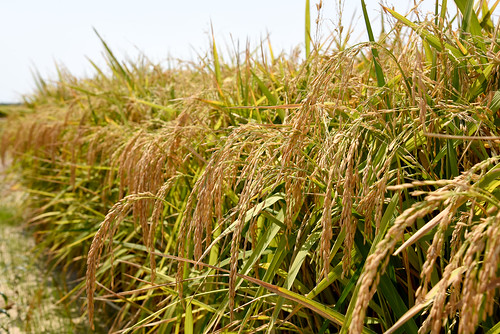Updated DD50 program improves accessibility, accuracy for rice management
By Fred Miller
U of A System Division of Agriculture
Fast Facts:
- Updated DD50 program features greater accuracy, accessibility
- Program more user friendly, especially on mobile devices
- More updates considered for 2019
(619 words)
(Download MS Word version )
(Art available for download at https://flic.kr/p/UBsaLZ)
(Related website: DD50 http://DD50.uada.edu/)
FAYETTEVILLE, Ark. — Improvements and updates to the University of Arkansas System Division of Agriculture’s DD50 rice management program provide more accurate reports and easier access, especially on mobile devices.

The Arkansas Rice Research and Promotion Board provided funding for the upgrade, said Jarrod Hardke, extension rice agronomist. Aristotle, Inc., a Little Rock-based web design company, was contracted to redesign the DD50 website. Extension IT staff, including developers Karen Watts and Becky Bridges, collaborated on the database programming and login functionality for producers.
Amy Cole, digital media program director for the Cooperative Extension Service’s office of information technology, said the program has been completely overhauled for 2018. All new computer coding has replaced the outdated program, making it faster and more user friendly.
Cole said the program features a new interface, is more usable on multiple web browsers, and is optimized for use on smart phones and tablets. “Functionality is improved and the interface makes more sense,” she said.
Cole said 249 Arkansas rice producers are enrolled in the program now, representing 2,711 fields totaling more than 215,000 acres.
DD50 provides information and help with timing on more than 25 management decisions based on constantly updated weather conditions, Hardke said. Among them, the program helps farmers time applications for nitrogen fertilizer and insect and disease pest control, and herbicide cutoff dates.
“DD50 can help rice producers stay very much on track with data-driven management decisisions,” Hardke said.
The program uses 30-year average high and low temperatures for each day in localized areas of Arkansas’ rice-growing land, Hardke said. The temperature data is constantly updated by daily readings from NOAA weather stations located throughout the state. That temperature data is used by the program to calculate heat units, called DD50 units.
The new DD50 program has access to many more of those stations than it did before the upgrade, Hardke said, making it considerably more accurate for more farms in more places.
Decades of Division of Agriculture rice research has demonstrated how those heat units affect plant development. “The program uses the accumulation of DD50 units to track growth and progression of the plants,” Hardke said. “That information helps growers time key actions that help ensure optimum rice yields and quality.”
Hardke said two options are available for farmers or crop consultants who want to participate in the DD50 rice management program The first option is for producers or consultants to log onto the Cooperative Extension Service website and enter their fields directly at http://DD50.uada.edu/.
The second option is for producers to submit the cultivar, acreage, and emergence date information for each rice field to their local county Extension Office. Extension agents will enter the information into the program and send the report to the producer.
Hardke said the preferred option is for producers and consultants set up an account and enter their own fields so they can check the program for updates as the season progresses.
An online DD50 User’s Guide is available to individuals who access the program through the internet.
“We encourage growers to check the program frequently, especially in a hot year like this one,” Hardke said. “The faster accumulation of DD50 (heat) units means the plants are progressing more quickly and timing of management actions becomes more critical.”
Hardke and Cole plan to keep looking for ways to make the DD50 program more useful. Hardke said a possible upgrade for next year could include an option to receive text or email alerts. Those alerts could be to give a heads up when five or six of the most critical management actions are coming up or when a significant development in DD50 units causes a change of two days or more in one of those actions.
“The point would be to make sure growers don’t miss specific timings that are critical for a successful crop,” Hardke said.
About the Division of Agriculture
The University of Arkansas System Division of Agriculture’s mission is to strengthen agriculture, communities, and families by connecting trusted research to the adoption of best practices. Through the Agricultural Experiment Station and the Cooperative Extension Service, the Division of Agriculture conducts research and extension work within the nation’s historic land grant education system.
The Division of Agriculture is one of 20 entities within the University of Arkansas System. It has offices in all 75 counties in Arkansas and faculty on five system campuses.
Pursuant to 7 CFR § 15.3, the University of Arkansas System Division of Agriculture offers all its Extension and Research programs and services (including employment) without regard to race, color, sex, national origin, religion, age, disability, marital or veteran status, genetic information, sexual preference, pregnancy or any other legally protected status, and is an equal opportunity institution.
# # #
Media Contact: Fred Miller
U of A Division of Agriculture
Arkansas Agricultural Experiment Station
(479) 575-5647
fmiller@uark.edu